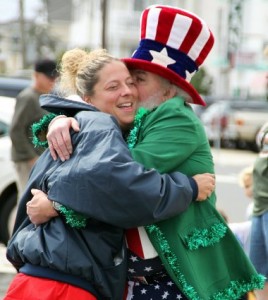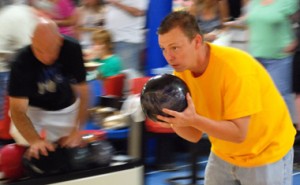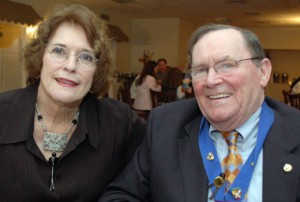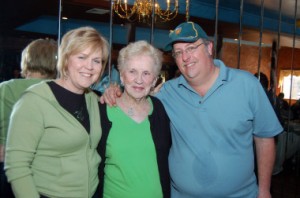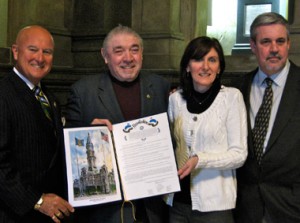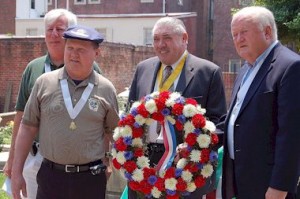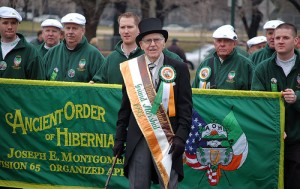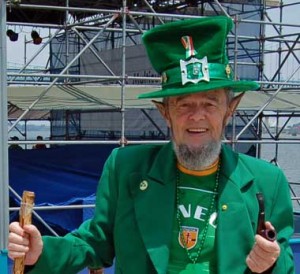
Ed Slivak at the Penn's Landing Irish Festival.
The 2009 Conshohocken St. Patrick’s Day Parade was over. Ed Slivak had spent the afternoon traipsing up and down Fayette Street dressed up as Swedesburg AOH Division 1’s leprechaun—bent pipe, pointy ears, green top hat, orange beard and all. It had been a great parade, and Slivak was on top of the world.
“I was happy as hell,” he recalls. “I’d been waving to everybody. At the end of the parade, I stopped at a tavern for a beer, but I suddenly didn’t feel so good. I bumped into a friend, Jimmy Gallagher (the district justice in Bridgeport), and he got someone to drive me to my car. So I drove home, and I got out of my car. And that’s all I remember. The next thing I know, I was in Montgomery Hospital. I didn’t remember anything.”
Slivak, a member of the vibrant Montgomery County division of the Ancient Order of Hibernians since 2001, had suffered a debilitating stroke. What followed were five long, often discouraging months of hospitalization and rehabilitation. He’s back home now in Swedesburg with his wife Gi (short for Virginia) and their little pug General Patton, and slowly getting back on his feet again, seeing a physical therapist twice a week. Still, there’s no question that it’s been a long road.
“It scared the hell out of me—I’m lucky to be alive,” says Slivak, 68, who credits his wife for nursing him back from the brink. “If you met me today you wouldn’t believe how I’m getting around. You can hear I’m talking pretty good. Sometimes it takes me time to think a little more. At one point, I dropped down to 114 pounds; I had been up to 210. I’m back to 145 now. I think the Lord was calling me for judgment day, but St. Patrick, St. Brendan and St. Bridget all went to the Lord, and they gave me a little extra time on earth.”
Slivak’s abiding faith—he’s a member of Sacred Heart Parish near his home—gives him the courage to keep on going, to take what probably seem like giant steps toward recovery, like moving from a walker to the use of a cane. He treasures the loving support of his wife and children, which gives him additional strength. Without them, he confesses, “I would have given up.”
But Slivak has one other powerful incentive to get better. He is the grand marshal of the 2010 Conshohocken parade.
He’s known about the honor for quite some time. “Judge Gallagher told me about it while I was still in the hospital,” he says. Now he’s counting the days until March 6—the Grand Marshal’s Ball—and, finally, March 13, when he, his wife, grandchild Michael and great-grandchild Clare will hop into a convertible and slowly drive down Fayette Street at the head of the parade.
You might be wondering how a guy with the last name of Slivak gets to be grand marshal of a St. Patrick’s Day parade. Slivak, he explains, is his stepfather’s name. “He took care of me,” says Slivak, who was raised in Philadelphia’s Fishtown neighborhood and attended Immaculate Conception Church. “He was a good man.”
The Irish heritage is all on his mother Clare’s side. She was a Ward, and her father Bernard, a one-time boxer who fought under the name Joe Dougherty, was from Donegal. Slivak’s grandmother Marie was a Murphy, who came to the United States from Cork. He remembers spending a lot of time with her—and he fondly recalls her as a colorful, if plain-spoken character.
“Nana was born in 1875,” he says. “She just loved St. Joseph. She had an icon of him, and she said the rosary a lot. Nana often liked to have a cup of tea with me. One day when we were drinking our tea, I asked her: Do you hate the English? She said to me, you can’t get into heaven hating anybody—I just don’t like them. Nana had a great influence on me in life.”
So there was never really any question about Ed Slivak’s pedigree. But his Irish heritage never truly resonated with him until he retired from his job at the Philadelphia Inquirer—he was a tearsheets clerk—and moved to Swedesburg in 2001. That’s the same year he joined AOH Division 1 on Jefferson Street.
“It’s a big Irish family when you join the AOH,” Slivak says. “I remember, I didn’t know what the initials stood for. But in the past 10 years I’ve learned a lot more about being a Catholic and Irish.”
It was Slivak’s membership in the AOH that led to his star turn as a leprechaun. Pete Hand, president of the division, approached Slivak one day about six years ago and suggested that he dress up as a leprechaun. (Hand insists Slivak looks like a leprechaun even without the get-up.) That first year, Slivak recalls, his costume wasn’t very good: “I looked like an immigrant, just off the boat.”
He also wasn’t very comfortable in the role. “The first time,” he says, “it was for a St. Paddy’s parade. I felt a little goofy. I thought, here I am a grown man dressing up as a leprechaun.”
The next year, Hand and Slivak resolved to do better, and they purchased a costume on eBay for about $225. “After that I started hamming it up,” he says. “The next thing I know, people are coming up and wanting their picture taken with me.” (One of those leprechaun fans was former President Bill Clinton, who was in Girardville, Schuylkill County, for the St. Patrick’s Day parade in 2007.)
Slivak has settled into the part with great enthusiasm. He’s especially fond of kids, who are always astonished to find a real, live leprechaun in their midst—and a big one at that. “I tell them in a brogue that I’m from Donegal, and that leprechauns are bigger there,” he says. “They ask me how old I am. I tell them I’m 386 years old. I give them a lot of blarney.”
The self-proclaimed “Polish leprechaun” has also used his celebrity status to do a lot of good for kids. He takes up collections wherever he goes in his costume and raises money for St. Christopher’s Hospital and Ronald McDonald House. Every year, he manages to collect a couple of thousand dollars.
With all that has happened to him in the past year, though, Ed Slivak’s leprechaun days soon will be over. He’ll be handing over the duties to an apprentice—an 11-year-old boy.
On March 13, Division 1’s celebrated leprechaun will make one last appearance in full regalia, in the 2010 Conshohocken parade. After all, Slivak says, “That’s what got me there. I’m like a Santa Claus when there’s a parade.”

